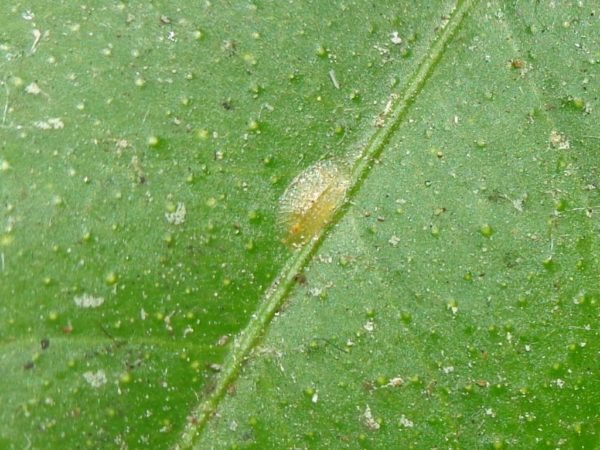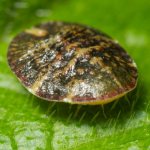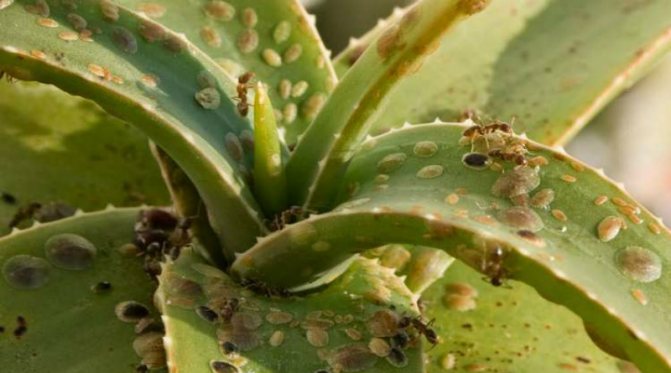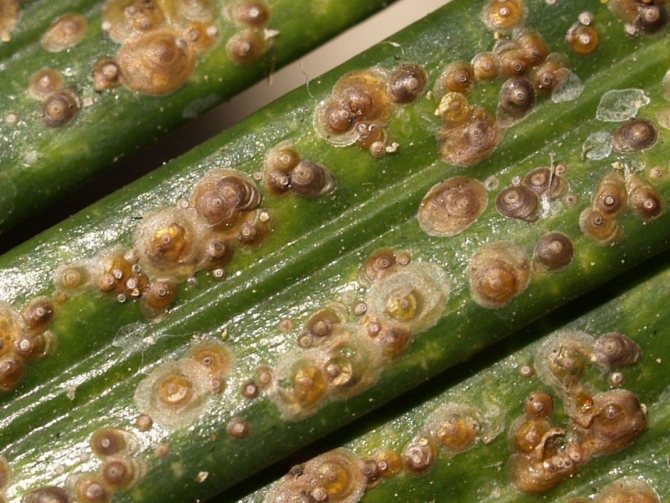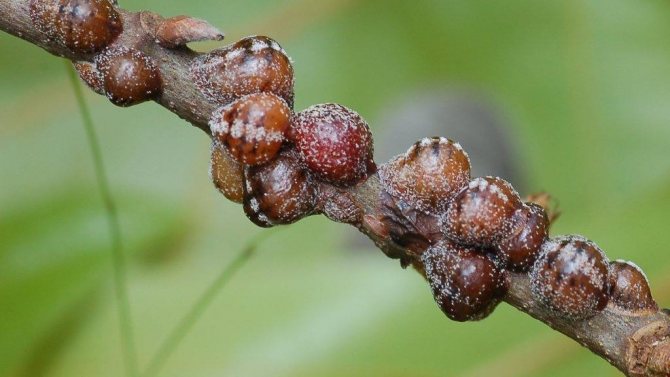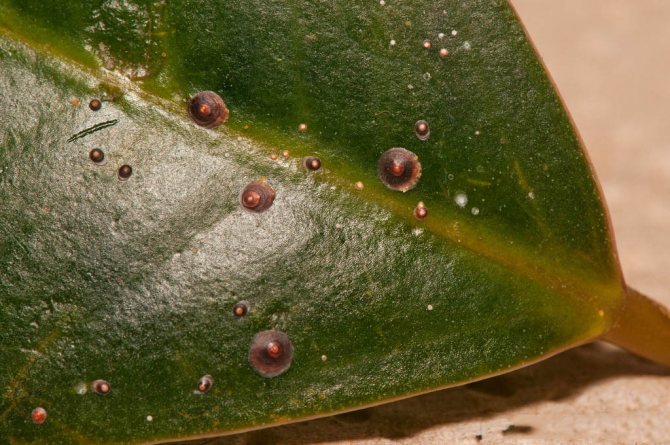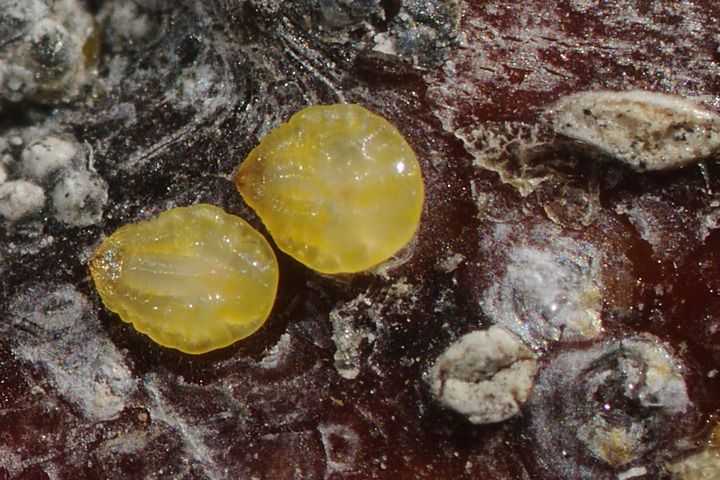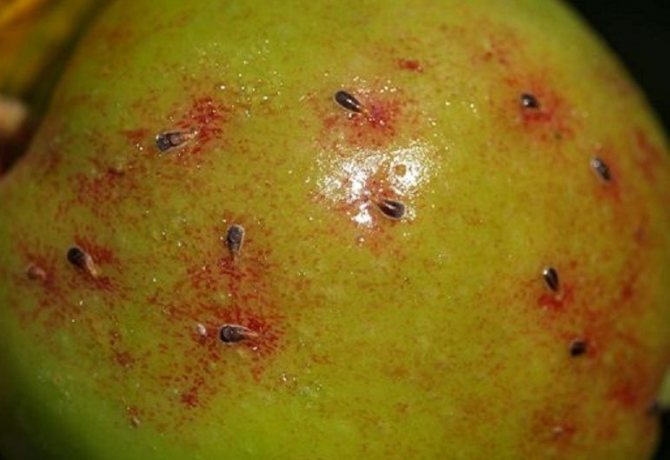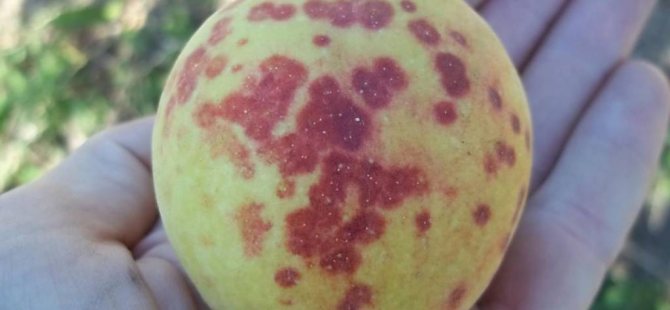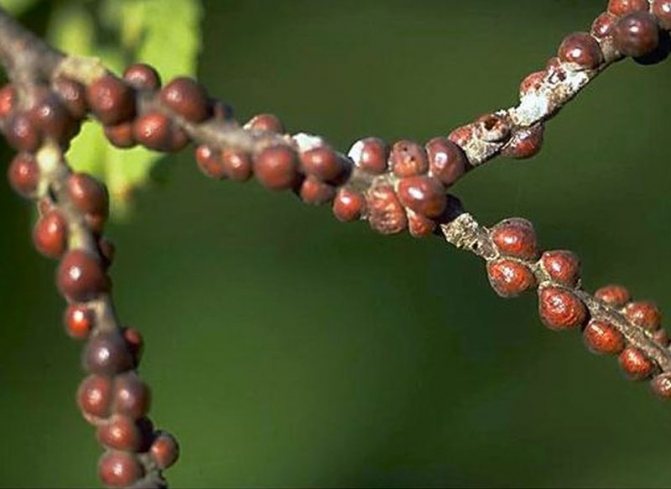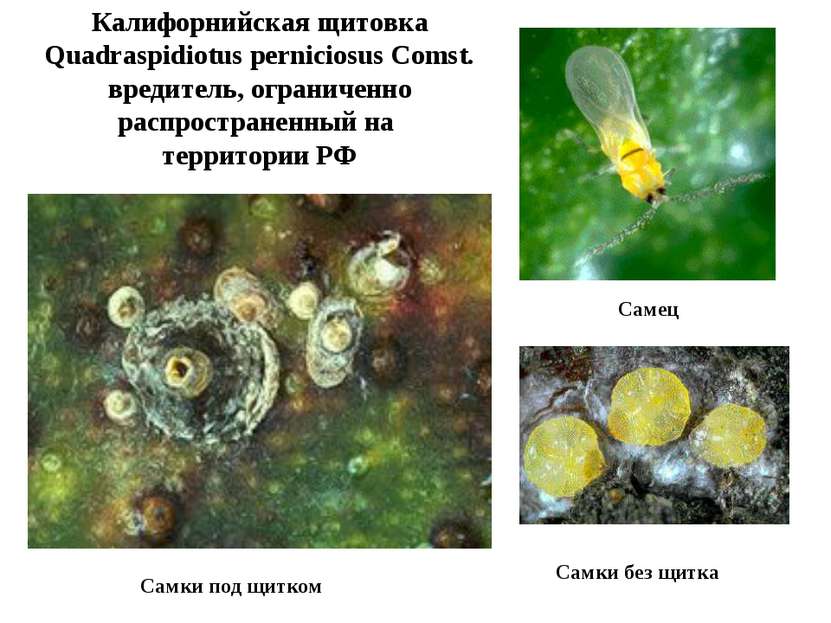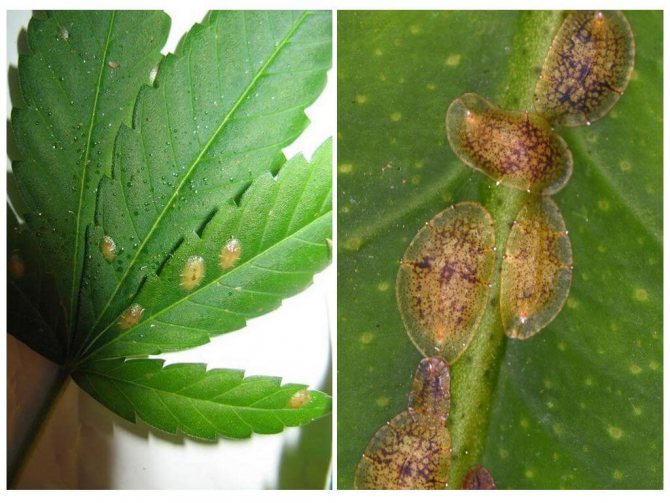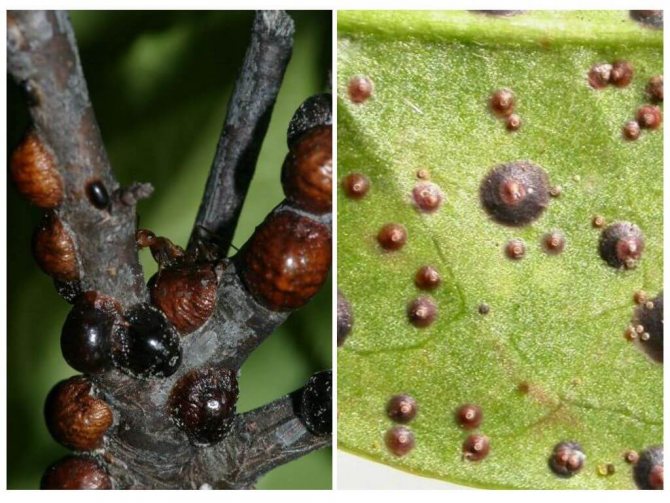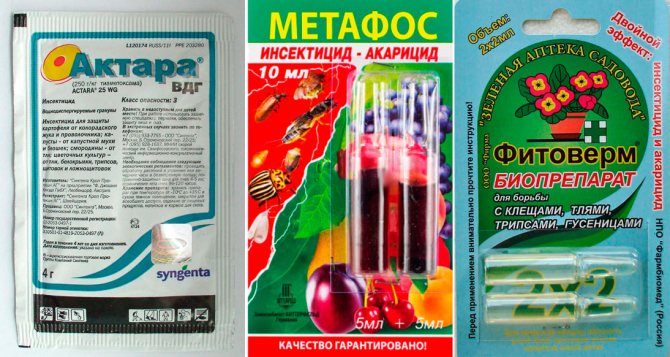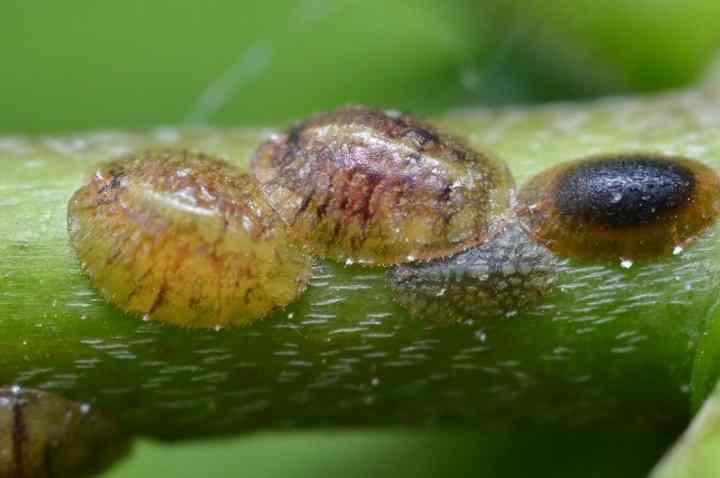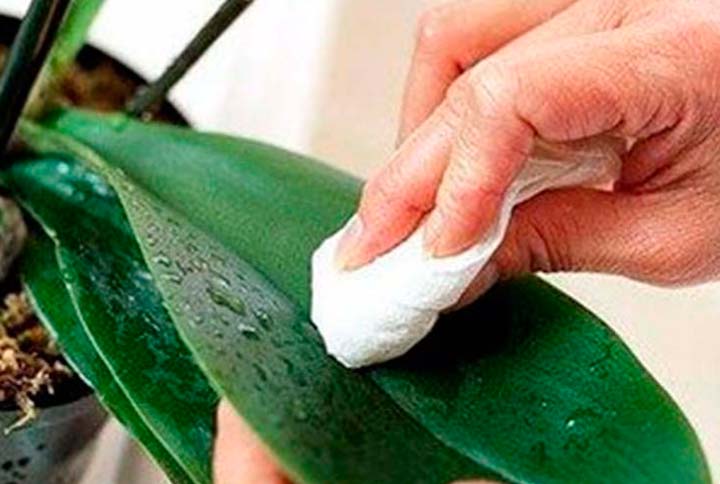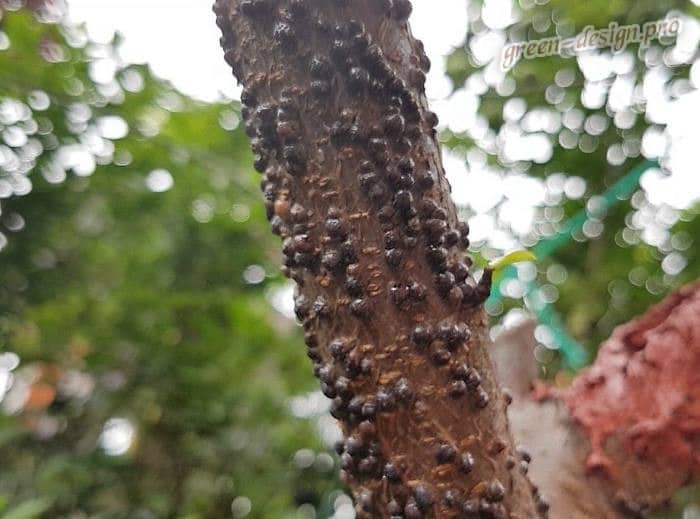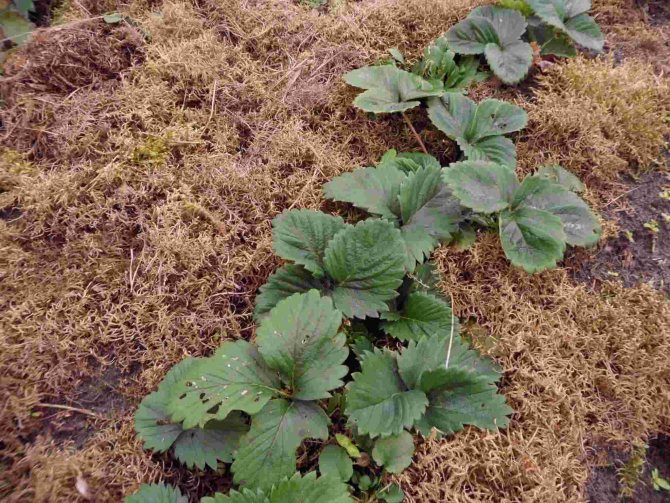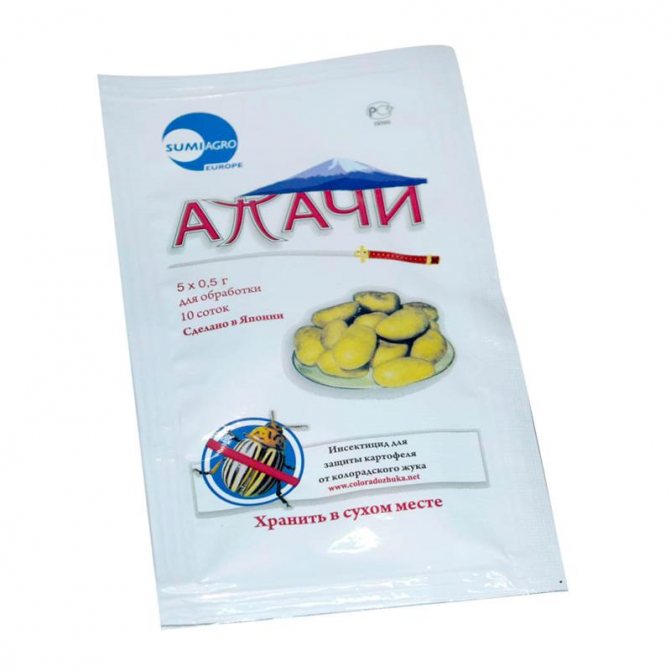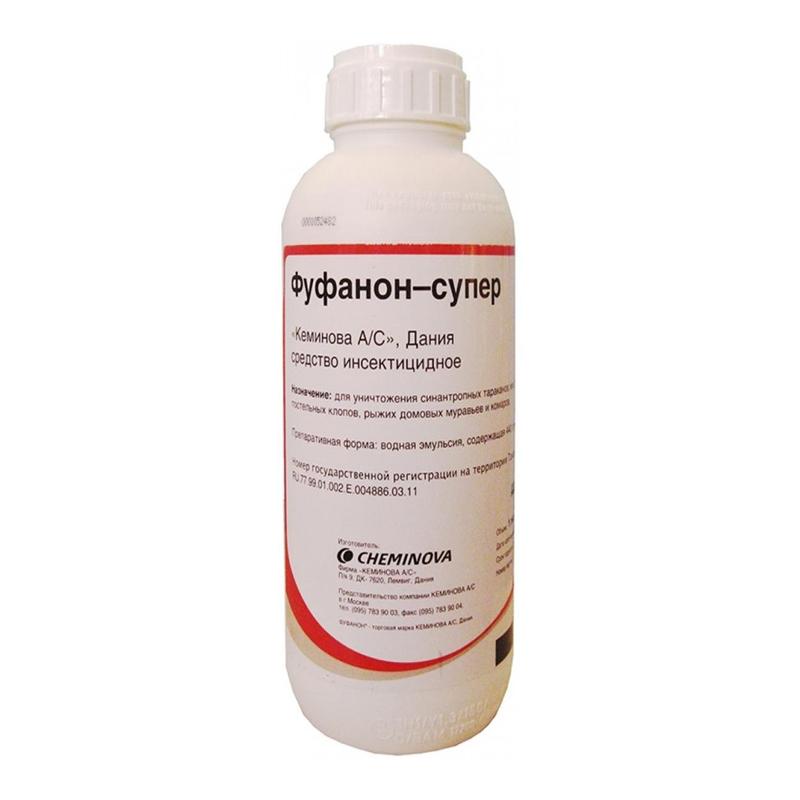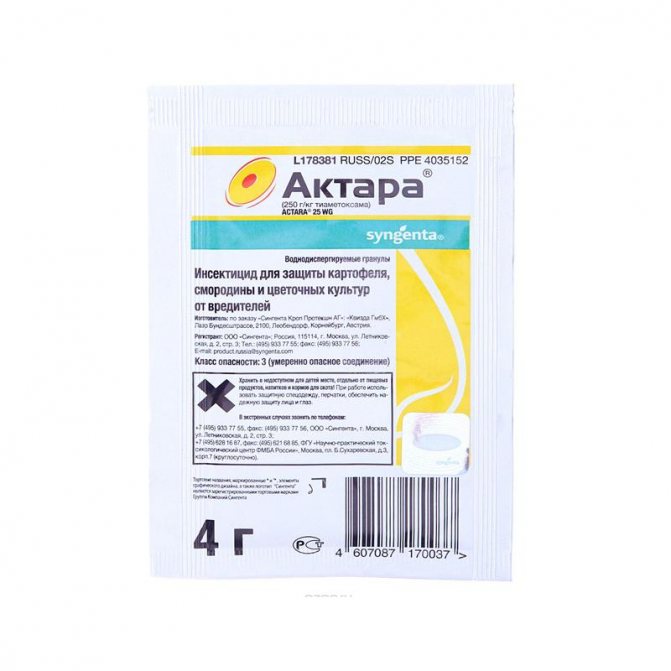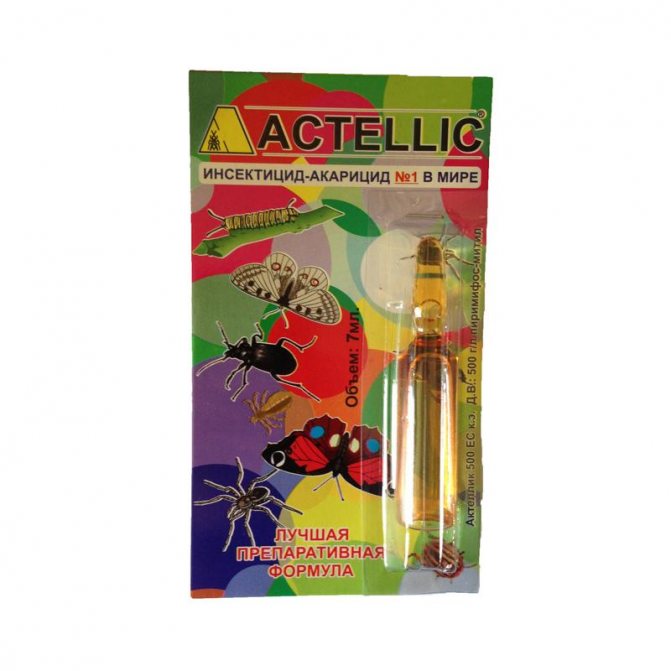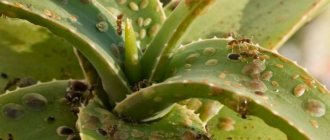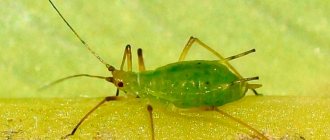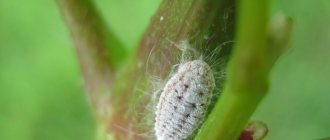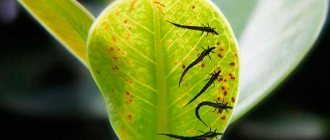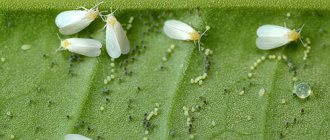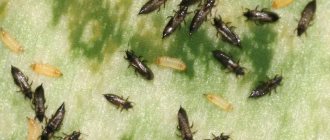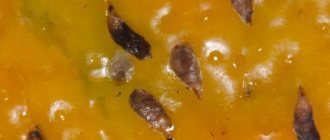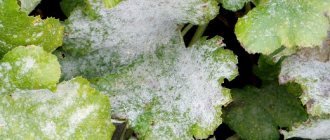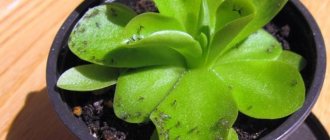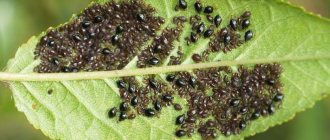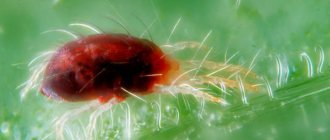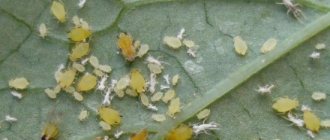Experienced flower growers know firsthand how dangerous the scale insect is. Distinguishing this insect from other pests is not so difficult: a characteristic feature is the presence of a protective coating that can easily be mistaken for a turtle's shell. Favorite habitats of scale insects are leaves, petioles and stems, to which they adhere tightly with their bodies. Having found at least one of this insect on a houseplant, it is necessary to urgently start to act, otherwise, soon there will be no living flower left in the house.
- 2 How to get rid of scale insects on indoor plants?
2.1 Chemicals to combat the scabbard
- 2.2 Folk remedies
Shields - description
Shields, Latin name - Diaspididae. A family of hemiptera insects from the superfamily of worms. There are over 2400 species in the family. The body is covered from above with a wax shield (hence the name of the insect).
All scale insects are distinguished by the fact that they have protective shields and look like plaques on the plant. The oral apparatus of all scabbards is sucking. They differ only in size and color. The scale insect is especially dangerous because, just a few hours after emerging from the eggs, the larvae have already settled throughout the plant and immediately begin to suck out all the juices from it, and the leaf surface is completely covered with scutes.
Brown scale (Chrysomphalus dictyospermi) damages mainly leaves, spreading on their upper side. The scutellum of an adult female is rounded, about 2 mm in diameter, reddish brown or dark brown. The scutellum of the male is smaller and oblong.
Reasons for the appearance
Where does the scale insect on indoor plants come from if the flower is kept indoors? Insects can enter from the street, get in with contaminated soil. The main reasons for the appearance of scale insects on indoor flowers are as follows.
- A new plant in the house. Immediately after purchase, the plant must be quarantined - placed separately from other flowers. Even if there are no visible signs of insect infestation, they may be in the larval stage. A new plant in your home is a potential hazard to all indoor flowers.
- Window. Young larvae could have entered through the windows with the wind. It is impossible to completely protect the flower from insects.
- Weakened plant. Weakened plants that do not receive enough nutrition most often suffer from pest attacks.
If scale insects are found on one of the flowers, it must be immediately isolated, the rest of the plants should be treated with alcohol or insecticide. The windowsill, pots, care items must be thoroughly rinsed and disinfected.
False shields - description
False scales differ from real scale insects in that they do not have a wax shell, and the eggs and larvae are protected by the drying skin of a dying female.
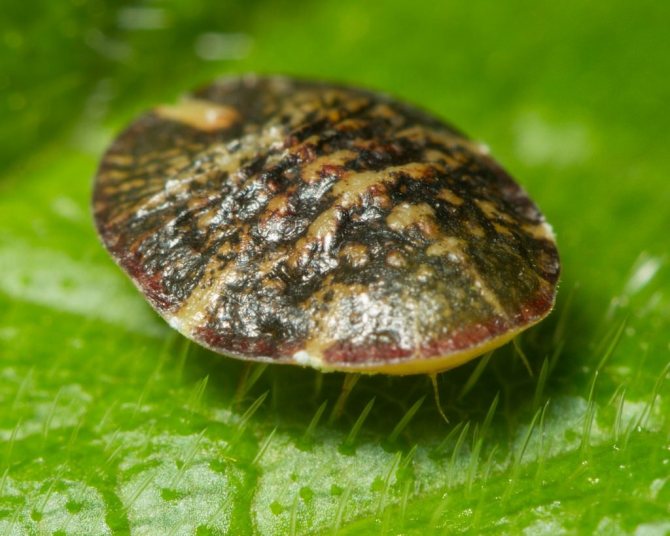
False shield (Coccidae).
False shields, or coccids (Coccidae) is a family of hemiptera insects from the superfamily of scale insects. More than 1100 species have been described, of which about 150 species are found in Europe.
Preventive measures
Prevention will help prevent the appearance and reproduction of scale insects. Florists recommend adhering to five rules.
- Quarantine.The newly purchased specimens are sent to quarantine - they are placed in a separate room, sprayed with a weak solution of insecticide and fungicide.
- Soap solution. Flowers are washed monthly with a mild soapy solution.
- Pruning and cleanliness. Sick, withered leaves are cut off. Plant residues are removed from the pot.
- Disinfection. The plants are periodically watered with a weak solution of potassium permanganate.
- Conditions of detention. Do not allow crowding of plants on the windowsill. Provide optimal light and humidity levels.
Pests actively reproduce in hot weather in stuffy rooms. The room needs to be ventilated daily, avoiding drafts. In summer, plants are recommended to be placed on the balcony - hardening by natural temperature changes increases the resistance of flowers to pests.
Since getting rid of scale insects on indoor plants is difficult, there is no need to run the flower state. Regular inspections, occasional soap or mild insecticide treatments will help prevent infestation and death of the plant.
Reproduction of scale insects and false scales
Most species of scale insects reproduce by laying eggs, but there are also viviparous species. Pests keep on the lower and upper sides of leaves, shoots and plant trunks. Only young larvae settle, which stick to various parts of the plant, adult insects are not mobile.
With a strong infection, the leaves along the veins and the trunks of plants are covered with a kind of bloom, formed from a large accumulation of scale insects. In damaged plants, growth and development are delayed, the leaves turn yellow and fall off prematurely.
Shields and false shields secrete a sticky liquid - a pad, on which a sooty fungus settles, which further impairs the development of plants.
Scabbards and false scutes damage many indoor plants: palm trees, citrus fruits, oleander, ivy, cyperus, asparagus, aucuba and others.
Adults and larvae function all year round, sucking the cell sap from the plant. Damaged plants turn yellow, develop incorrectly, leaves often fall off, young shoots dry out.
Scabbards are fast-growing pests. Reproduction can be either asexual or conventional. It occurs by laying eggs under the scutellum, and some species are viviparous. After hatching, the scale insect goes through several stages of development. At the initial stage, the scale insects are very mobile, and can quickly spread, in particular, to neighboring plants.
Females are motionless, but males can even fly during their lives. However, the life cycle of the male is very short. They live only a few days, unlike women, who live for several months.
Under good conditions, more females are born, under bad conditions, more males. The composition of the population changes itself in such a way as to improve its mobility and move to a more favorable place for life.
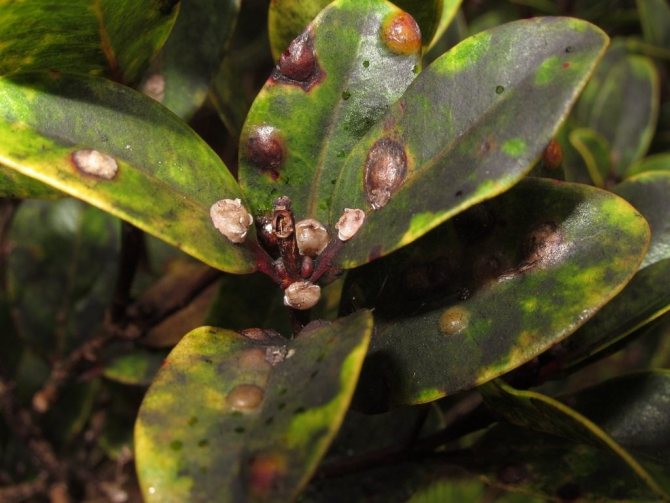

Ficus leaf affected by a false shield.
Signs of infection (external)
It is quite easy to detect these harmful insects. Outwardly, they look like small convex tubercles or plaques that have a rounded shape. Their color may be different. So, they can be colored green, yellow or brown. Most often, they are attached along the veins on the leaves, both on the outside and on the inside.
It is worth knowing that the scale insects produce a sticky secret. So, if the plant is infected very recently and the females are still almost impossible to see, then the leaves become quite sticky already at this stage.
Measures to combat the shield and false shield
Shields are protected from external influences by a shield, so the fight against them is not easy. The scabbards are cleaned with a toothbrush or a cloth soaked in alcohol or soap solution, you can also use a soap-kerosene emulsion.
Alcohol solution with soap... The mixture consists of 15 grams of liquid soap, 10 ml of denatured alcohol and 1 liter of warm water. However, one must be very careful here, especially for soft-leaved and thin-leaved plants. These species are very sensitive to alcohol, therefore they are not sprayed with liquid, but applied to the insects themselves with a brush. If you really want to use this method, it is best to do a small sensitivity test on one sheet first.
For severe damage, the following chemicals are used:
Actellik. Dissolve the ampoule in 1 liter of water and treat it during the appearance of the pest. Solution consumption up to 2 liters per 10 sq.m. No more than 4 treatments. The waiting period is 3 days.
Fosbecid.Treatment with these drugs (they are toxic) is best done outdoors (20 ml per 10 liters of water).
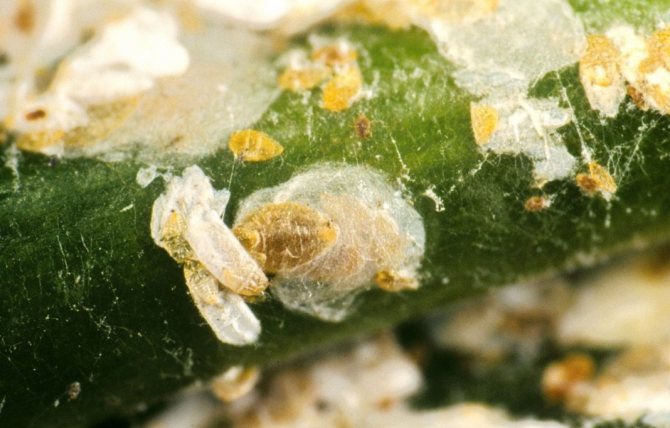

Shields.
If the plants are short (up to 30 cm), try watering them under the root with a solution of the drug "Aktara"... This insecticide penetrates plants through the roots and makes all of its above-ground organs toxic to insects for some time. When treating with an insecticide, wipe the windowsill or shelf where the plant stood, as well as the window glass, since small larvae may not be noticed.
To reduce the harmfulness of scale insects and false scale insects, one can also use the fact that the reproduction of many species of these pests is greatly slowed down by a drop in the relative humidity of the air and prolonged exposure to sunlight. Therefore, be moderate with watering, avoid crowding the plants, ventilate the room more often, isolate the infected plant from others, move it to a brighter place.
Traditional methods
It is ineffective to fight the shield with folk remedies based on garlic, onions, and pepper. Alternative methods are more suitable as a preventive measure against the appearance of the scabbard:
- Garlic (5 cloves) is crushed into gruel, poured with a glass of warm water, covered and insisted for 2-3 hours in a dark place. The resulting infusion is lubricated or washed stems and leaves or sprayed, after having filtered the infusion.
- A medium-sized onion is chopped and filled with a glass of water. Insist for several hours, apply in the same way as garlic infusion.
- Bitter pepper (50 g per 0.5 l of water) is chopped, boiled for several minutes over low heat. Insist day, filter, apply similarly to previous infusions.
With the active reproduction of scale insects on plants, funds are needed that give a quick effect, that is, you will have to use chemicals.
A source
Why do scabbards appear in the house?
Most often, this parasite enters the house along with any new plant.purchased from a flower shop. Usually, adults are not prone to migration. Having fixed in one place, they feed on the juice of the selected plant for their whole life. Young parasites are quite another matter. On the contrary, they are very active in search of food. Therefore, the infestation of neighboring flowers occurs very quickly.
To avoid such contamination, new flowers purchased in a store or in the market should be immediately after purchase. rinse with warm waterand then quarantine.
Quarantine activities should last for several weeks. This time is enough to identify the parasites. A beginner can be put together with other flowers only after the florist makes sure that there are no parasites.
What does a scabbard look like on indoor plants
The scale insect is a parasitic mite belonging to the family of Homoptera. Lives off the fact that it feeds on the juice of green spaces. The size of the pests varies from 0.5 to 5 mm, depending on which species they belong to. If small tubercles have appeared on the leaves, then, most likely, a scabbard has appeared on them.
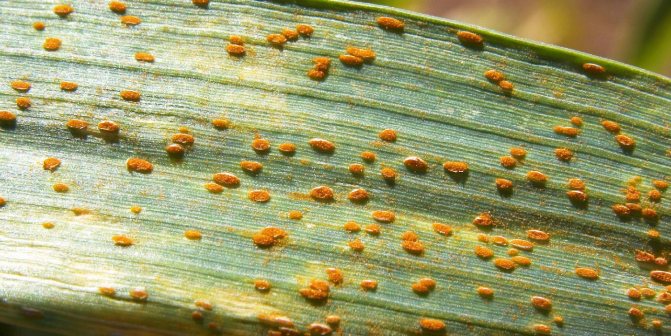

Leaves affected by the scutellum are covered with unpresentable tubercles.
Important! The scabbard is covered with a durable carapace, which makes it difficult to fight it.
There are differences between females and males. Females have a more powerful and rounded shell, often lacking wings, legs and eyes. They are absolutely motionless. Males have well-developed wings and legs. The shell is slightly weaker than that of females, oblong in shape. Underdeveloped mouth. Males have a very short lifespan, they die immediately after mating.
During reproduction, females lay eggs on the leaves, from which larvae appear over time. They are active for a short time, for several days, and then become stronger on stems and leaves.
What harm does the scale shield do to indoor flowers
The appearance of scale insects on indoor plants is really destructive for them. There are cases when pests have destroyed a fruit tree in 3 - 4 years. And this is not an exaggeration. In practice, when a scale insect is found in the garden, a quarantine is declared.
Leaves infected with the scabbard first turn yellow, then dry out completely.
Important! The appearance of the scale insect first of all leads to the appearance of a fungus, which spreads rather quickly on the stems, leaves and roots. The insects themselves, feeding on the sap of the plant, weaken it. If you do not take measures to combat the scabbard in time, the plant will die, completely dry out.
Signs of damage with a scabbard
You can understand that indoor flowers in a house are affected by a scabbard by several signs:
- The appearance of plaques on leaves and stems. These are small raised spots, the shade of which varies from light yellow to brown.
- The formation of a sticky coating. At an early stage of infection, droplets with a transparent and sticky structure are observed. And over time, plaque forms on the entire surface.
- The plant stops growing. Leaves turn yellow, dry up and fall off.
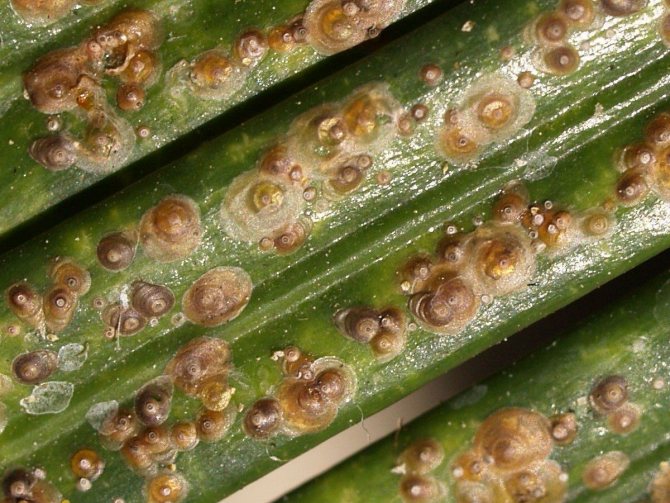

Signs of damage with a scabbard on a plant
Very often, a fungus forms at the places of settlement of the scale insect. All this contributes to the clogging of pores, disruption of photosynthesis. If the plant is not helped, it will dry out completely.
False shield on indoor plants
In addition to the scale insect, there is a similar insect, the false scale insect. They may look the same and beginner growers often confuse them.
But there are several signs by which you can easily distinguish pests from each other.
If a false shield has settled on a plant, then there is no sticky liquid and plaque on it. The carapace is not firmly attached to the insect's body. Therefore, if you take up the flap, it will immediately detach from the calf. Differs in carapace and shape. In scale insects, it is rounded, like a pea, in false scales, it is flatter.
Varieties and their photos
Consider all types of scale insects that exist and their features.
California
This type of insect is distributed exclusively in the southern regions, as well as in the Far East. The californian scale insect can infect about 200 species of plants of woody origin. Fruit trees, such as pear, apples, cherry plums, plums, are most suitable for her taste.
According to the phenocalendar, wintering at the Californian scale insect takes place on the bark of a tree in the form of larvae. In the spring, their larvae grow and turn into females or males. The larvae themselves have a shield. At the first stage, it is white, and then the color changes and becomes gray. Plants that are attacked by such insects quickly become weak and their bark cracks.
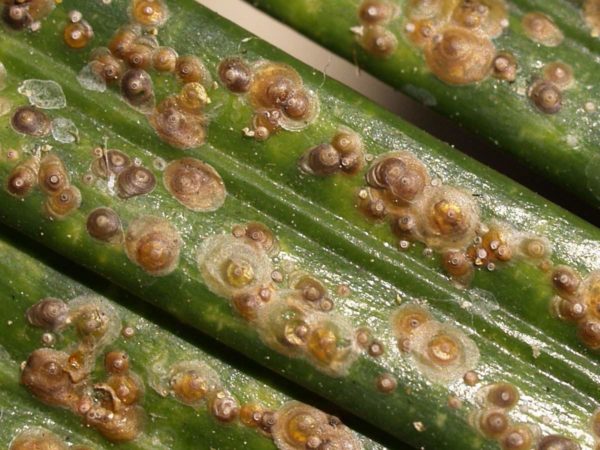

Watch a video about the Californian scale insect:
Mulberry
Both larvae and females of the mulberry scale are capable of developing and growing exclusively on thin shoots or branches. Often, exclusively female scale insects develop on the upper branches of plants, but males already live on the lower branches. Based on this, young and thin shoots are associated only with females.
If there are a lot of pests of this nature on the tree, then they cover it with white mucus., due to which the tree becomes like a birch.
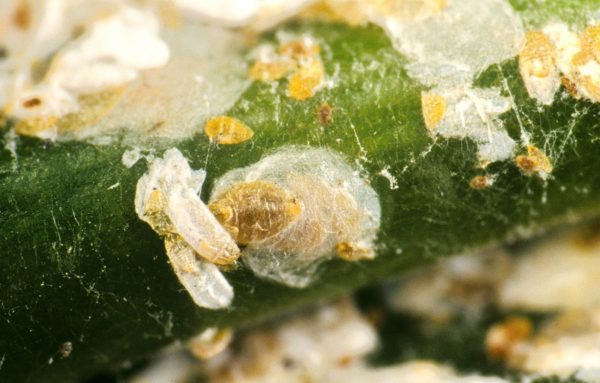

Comma
The comma-shaped scale insect is a half-winged species of insects.
Reference. It is also a pest of a large number of crops. But often this kind can be found in the area of fruit trees, and in particular - apple trees.
The comma-shaped scale has a body up to one and a half centimeters long. This body is located under the scutellum, which is twice the length of the body.
The female has a brown scutellum, and the male is lighter. At one time, the female can lay up to 90 eggs, this process takes place in August and often on the shoots of young trees. After the end of winter, the larvae hatch on their own and creep along various branches. Thus, a new generation of pests appears that suck the sap of the plant.
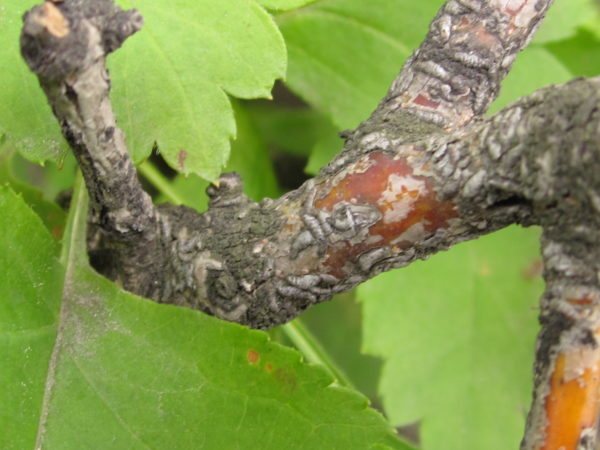

Palm
The palm scale has its name due to the fact that it damages a fairly large number of plants, but exclusively of palm origin. The scutellum of a female of this species has a transparent color, and in certain cases it can become gray. The male at the same time has a yellow shield color.
Pests of this type take up space on the bottom layer of the leaf. If they attack the plant en masse, they hit the leaf and it dries up.
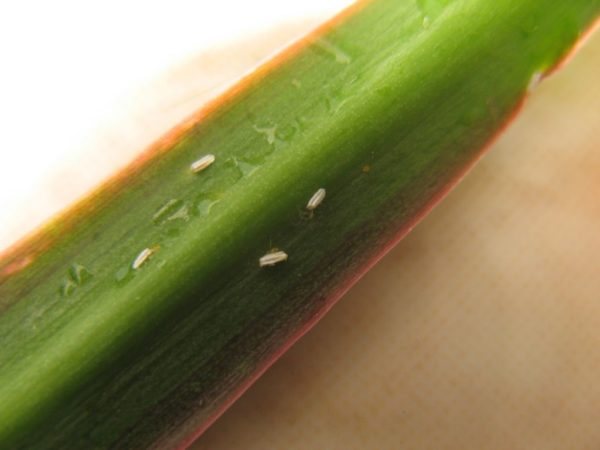

Pear-shaped
The pear-shaped pest is of European origin. The purpose of such an insect is plants of a fruit nature or stone fruit. Such an insect differs from its counterparts in that after the defeat of the fetus, the victim acquires pigmentation in the form of red spots.
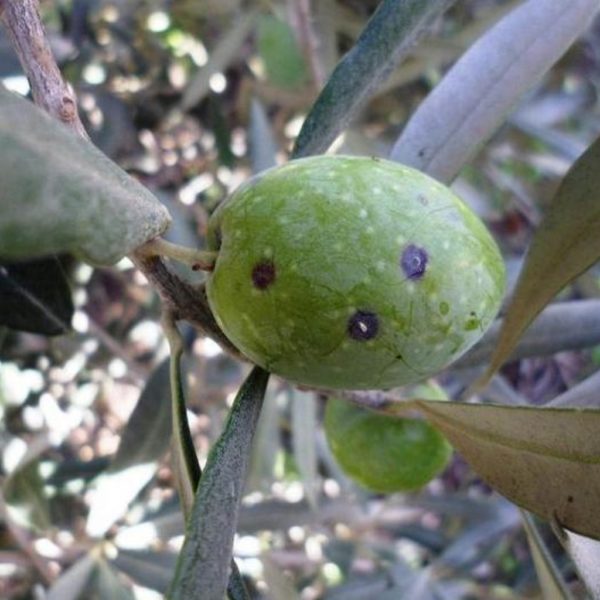

Orange
The orange scale scabbard affects only citrus plants. You can meet it only on oranges, lemons, pomegranates and grapefruits.
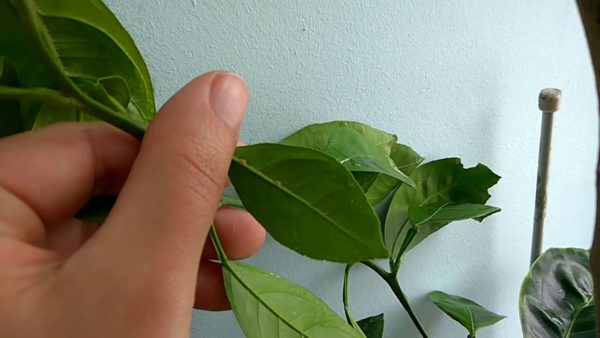

Orange
Important! The orange scale insect is a dangerous pest and affects crops of citrus origin. Such a pest can cause the fruits of the plant and its leaves to fall off, or even its complete wilting.
Shields of this type are small, up to two millimeters. Females of this species have a round body shape. As for the males, their scutellum has a flat character. Often this species has a red or brown color, but there are also yellow ones.
Adult male insects are small enough and have only two wings. They live no more than six hours, and die after mating. Unfertilized females are found by males according to a certain smell, which is pheromones.
In one year, insects of this type can give no more than eight generations and at least four. This species is exceptionally viviparous. On average, about 70 larvae can be counted per birth.
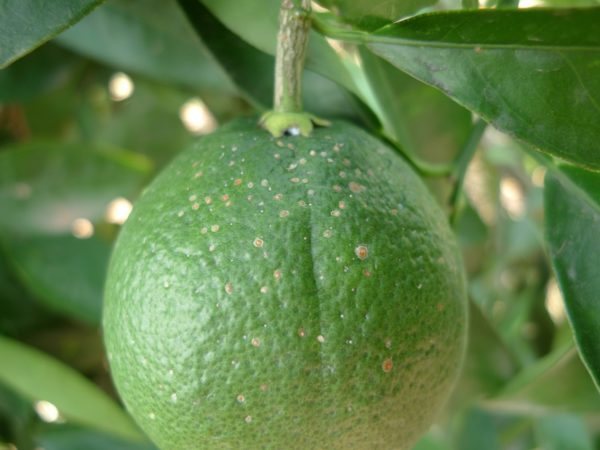

Pine
The pine scaled belongs to such a detachment as the Homoptera. The distribution of this type of scale insects affects the zone of the forest-steppe and steppe. The larvae of such a scale insect are capable of infecting pines and spruces, which in the future will cause these crops to dry out.
Reference. In order to combat these pests, it is necessary to identify them as early as possible. The best way to control these pests is by using systemic insecticides, for example, "Aktara".
This method is suitable only in the season when females feed for the birth of a new generation.
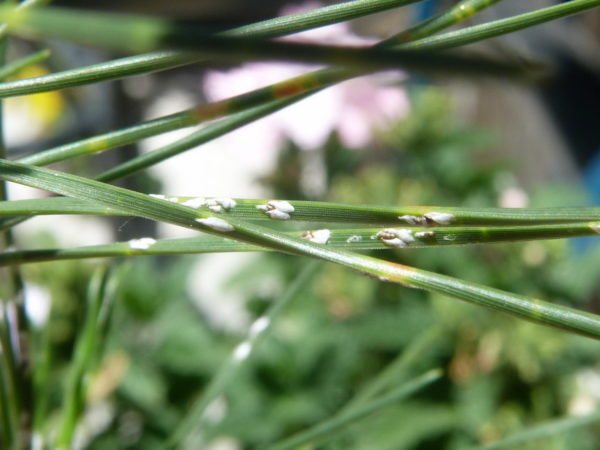

Other types
The soft scabbard damages a wide variety of plants. Its body length can reach up to four millimeters. The method of reproduction in soft scale insects is viviparous.
